Let’s work through the possible age of this monumental (and unstamped) piece.
| Type | Tin-lined two-handled sauté in hammered finish with brass handles attached with three copper rivets |
| French description | Plat à sauter étamé et martelé avec poignées en laiton munies de trois rivets en cuivre |
| Dimensions | 46cm diameter by 14cm tall (18.1 by 5.5 inches) |
| Thickness | 4mm at rim |
| Weight | 15338g (33.8 lbs) |
| Stampings | CM SL 55 46 |
| Maker and age estimate | Unknown; 1900s to early 1920s? |
| Source | Normandy Kitchen Copper |
This piece, at 46cm (18.1 inches) diameter, is a member of a species of copper cookware I categorize as a behemoth, scaled for a large professional kitchen. The photo below might give you a sense of its size.
 I am accustomed to calling this type of piece a “rondeau” but my research suggests that that term is a relatively recent innovation. Gaillard’s 1914 catalog calls this piece a plat à sauter a poignées — a sauté pan with two handles, distinct from the one-handled plat à sauter (which in the present day we would call a sauté pan). Gaillard offered the piece with a close-fitting couvercle à emboîtage with side-mounted handles aligned with the pan’s handles so that they could be securely grasped together. This style of lid was offered for plats à sauter like this one as well as for marmites (stockpots, particularly of English make) and daubières.
I am accustomed to calling this type of piece a “rondeau” but my research suggests that that term is a relatively recent innovation. Gaillard’s 1914 catalog calls this piece a plat à sauter a poignées — a sauté pan with two handles, distinct from the one-handled plat à sauter (which in the present day we would call a sauté pan). Gaillard offered the piece with a close-fitting couvercle à emboîtage with side-mounted handles aligned with the pan’s handles so that they could be securely grasped together. This style of lid was offered for plats à sauter like this one as well as for marmites (stockpots, particularly of English make) and daubières.
Indeed, looking straight on from the side, you can see that this pan anticipates a lid. The handles are mounted quite low and the handgrips droop slightly, providing clearance for the handles of a fitted couvercle à emboîtage.
Unfortunately many a pan and its fitted lid have been separated over time. I do occasionally see a solo lid show up for sale online — such a lid was intended to double as a shallow pan on its own, and often a seller will describe it as a rondeau or even a tray without recognizing that it is in fact a couvercle à emboîtage. There will be two key differences between a couvercle à emboîtage and a rondeau: a lid will be quite shallow for its diameter, no more than a few centimeters tall, and the handles will be set to project horizontally in order to meet but not collide with the mated pan’s handles.
Another piece of information I take from that 1914 catalog is that Gaillard was making plats à sauter a poignées up to a diameter of 54.5cm (21.5 inches). I can only hope that somewhere out there is a full-size specimen as yet undiscovered, like plesiosaurus lurking in the depths of a Scottish loch.
But I digress.
The handles on this piece are in the classic French style and they are enormous. I measured the span of the baseplate at 18cm (7.1 inches), with handgrips flaring to a width of 15cm (5.9 inches). That’s entirely appropriate for a 4mm thick piece that weighs 15338g (33.8 lbs) unladen.
But as massive as the handles are, one of them has cracked. The right-hand arm of the handgrip has been repaired with what looks like brass braze.


I expect that the broken handle was removed for the repair and then replaced. This gives us an opportunity for a rivet comparison. In the photo series below, the repaired handle is on the left (spanning the vertical cramp seam), and intact handle is on the right. Compare the exterior and interior appearance side-by-side. (I also wish to draw your attention to the mirror-smooth surface of the tinning. I believe this piece was expertly retinned for Normandy Kitchen Copper by Atelier du Cuivre in Villedieu, and they deserve much praise for such beautiful work on a piece this size.)



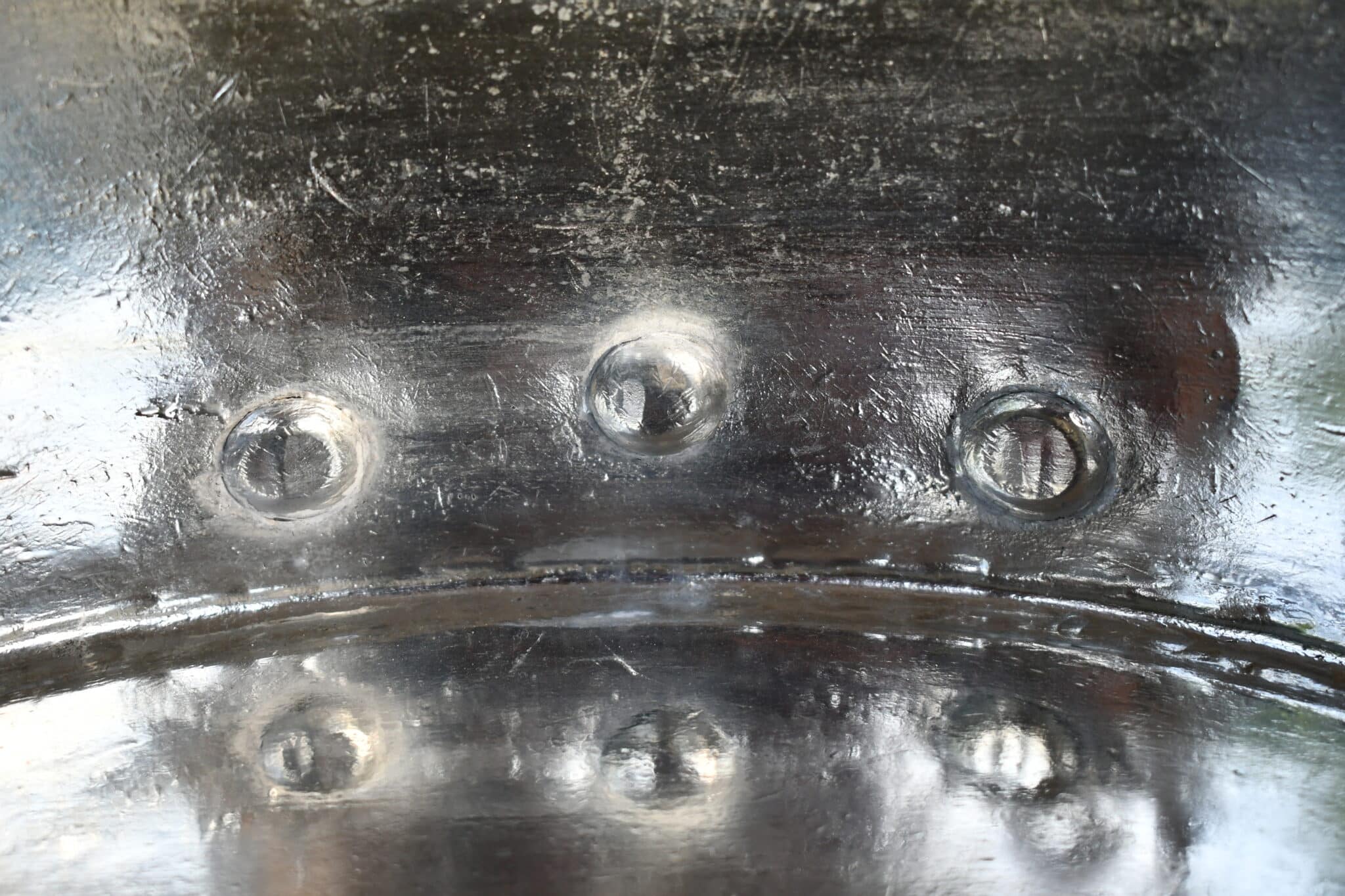
I don’t know about you, but for my part, I can’t see much of a difference in workmanship between the two sets of rivets. In many cases of handle or rivet replacement I see obvious differences between the original and repair riveting, which I generally ascribe to the work of a different metalsmith well after the piece was manufactured. But the visual similarity in this work suggests that the repair was done just like the original — perhaps by the manufacturer, and perhaps during the same era of craftsmanship. An alternative possibility: Both handles could have been removed and re-attached. This would not be out of the question for the handles on a piece this massive, which would be subjected to enormous torque during routine daily use. I wish I had a definitive answer here, but as is so often the case with antique copper, I can only surmise.


The three groups of stamps on the copper do not include a maker’s mark. The “46” is a size stamp positioned above the intact handle opposite the cramp seam and it specifies the piece’s internal diameter in centimeters; “CM” and “SL” are owner’s marks applied halfway around the sidewall between the two handles. The number 5 is stamped twice, horizontally and vertically, on the sidewall opposite the owner’s marks. The pan’s geometric volume is just over 23 liters (6 gallons), so “5” could not be a capacity measurement. Instead, I believe this is a kitchen identifier, suggesting that for a period of its history this pan was “number 5” to the kitchen staff. (Could the horizontal “5” mean that the pan was stored on its side, like a book in a bookshelf? Hmmm….)



Right now, taking all these observations into account, I am tentatively dating this piece between 1900 and the early 1920s.
The first key data point for me is its 4mm thickness. My observations of the copper market over the last few years is by no means an exhaustive or complete study but I have come to believe that 1 to 2mm thick copper cookware was the normal range up into the mid 19th century, and thicker grades of copper — 2.5mm to 3mm — began to become available in the 1880s to 1890s. I start to see super-thick copper at 3.5 to 4mm bearing stamps for Gaillard, Jacquotot, and Dehillerin that I have tentatively dated between 1904 to 1930s, corresponding to the jazz age — the années folles, the inter-war peak of Parisian restaurant and theater culture. I believe this was the great alignment of supply and demand for the French copper cookware industry: the armaments industry of World War I created powerful metal presses that could mill, cut, and shape super-thick copper, and the great restaurants and hotels in the culinary capitals of Europe demanded heavy-gauge cookware to manage the heat put out by increasingly massive (and hot) coal- or gas-fired iron stoves. My assessment is that the thickness of this pan makes it a 20th century piece.
But there is a second key data point that contradicts this: the cramp seams (aka dovetails). This pan is made from two pieces of copper joined together by hand. The edges of each piece were sliced with a series of radial slits, interleaved, hammered flat, and sealed with brass braze. This is an age-old technique to join copper sheets that is still used today for repairs or small scale production but no longer at an industrial scale. Dovetailing was supplanted in the early 20th century by two more efficient and economical techniques: welding, which joins metal more quickly and resiliently, and by metal presses capable of shaping thick sheet and in many cases obviating the need for joinery at all.
But I would not expect to see welds on a shallow 20th century piece such as this. Instead, I would expect it to be seamless — that is, shaped with a die press. I have reason to believe that Gaillard had access to die presses powerful enough to work 4mm sheet copper by the early 20th century: see this 36cm Gaillard rondeau (1890s to 1904), this J. E. Gaillard 44cm sauté (1904-1920ish), and this 40cm J. Gaillard rondeau (1920s-1930s). As always, these three examples are only as good as my amateur research into their stamps but I believe my age estimate for them to be reasonably correct.
But at 46cm, this piece is wider and correspondingly more massive than those examples, and that suggests another possibility. Shaping pots in a press requires a die corresponding to the desired dimensions of the finished piece. Could it be that the maker of this piece had a perfectly capable metal press, but lacked a 46cm die? Could this piece be a contemporary of the examples above — perhaps unstamped Gaillard — but just slightly too large to have been formed on the die press at hand?
Ultimately, as with all unstamped pieces, my process of age estimation is just that, combining observations from other (dated) pieces and some common sense. I put this piece between 1900 to the 1920s, more or less.
Readers, you’ve seen a lot of pieces over time — what do you think?

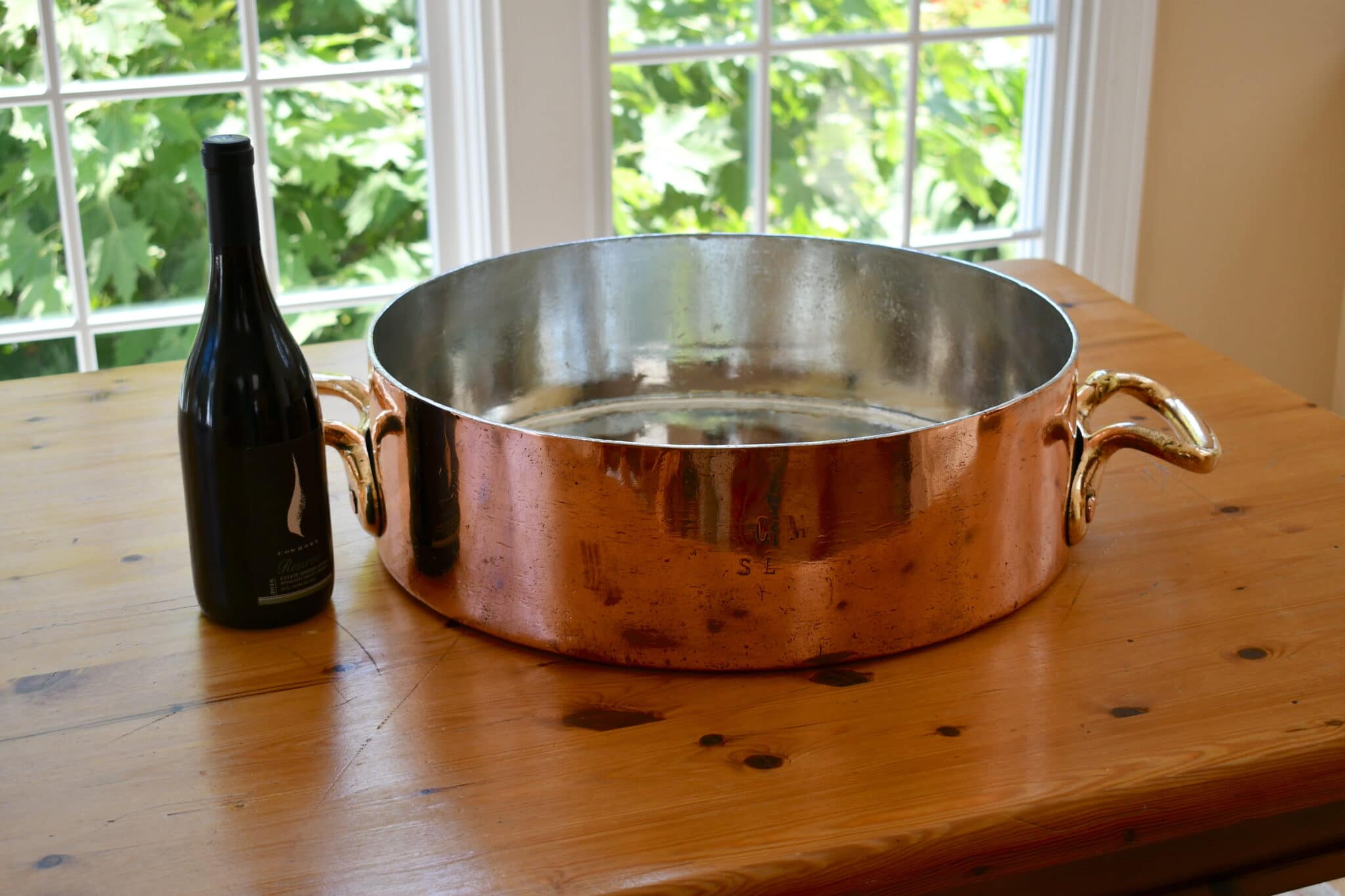
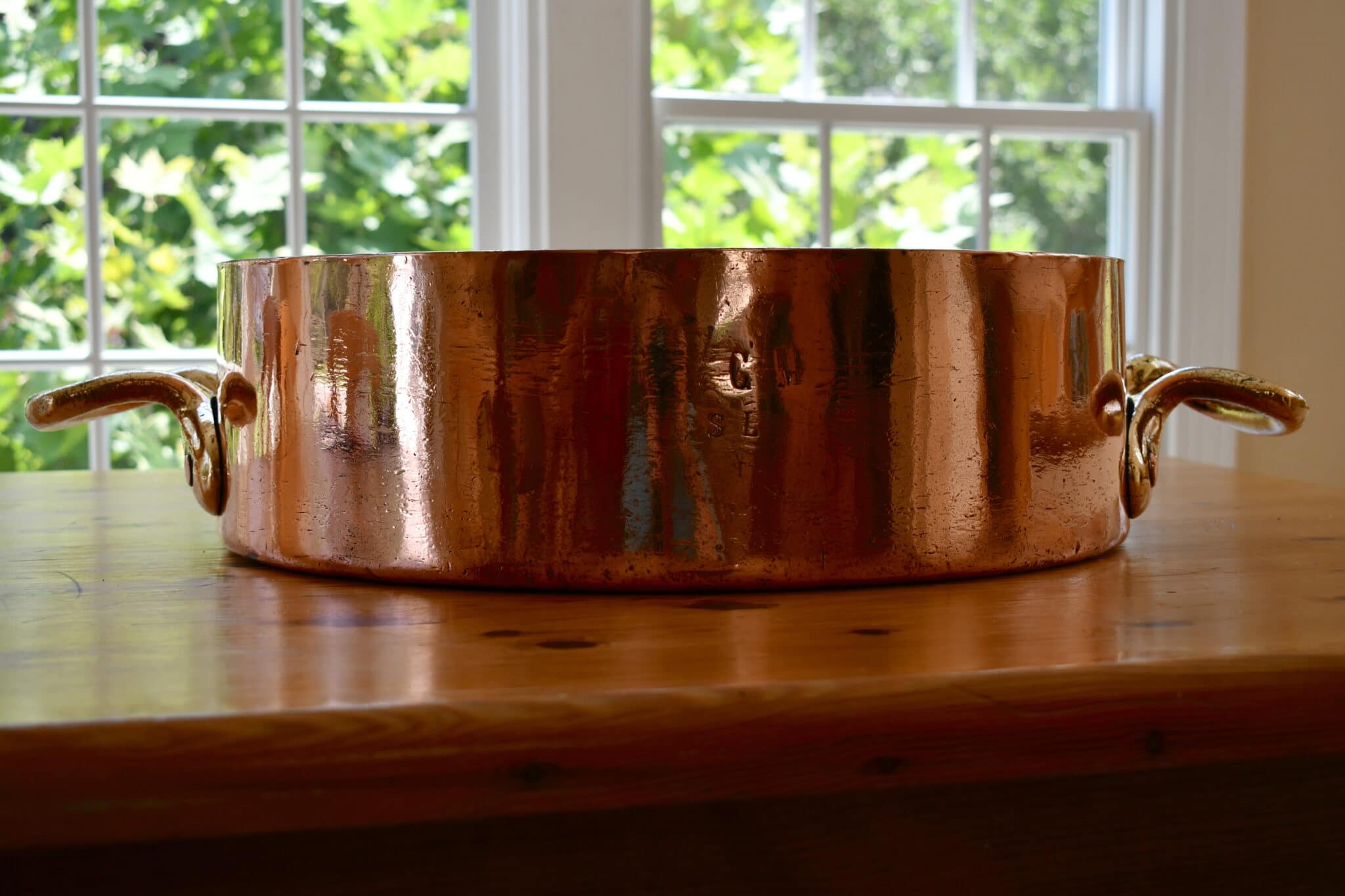
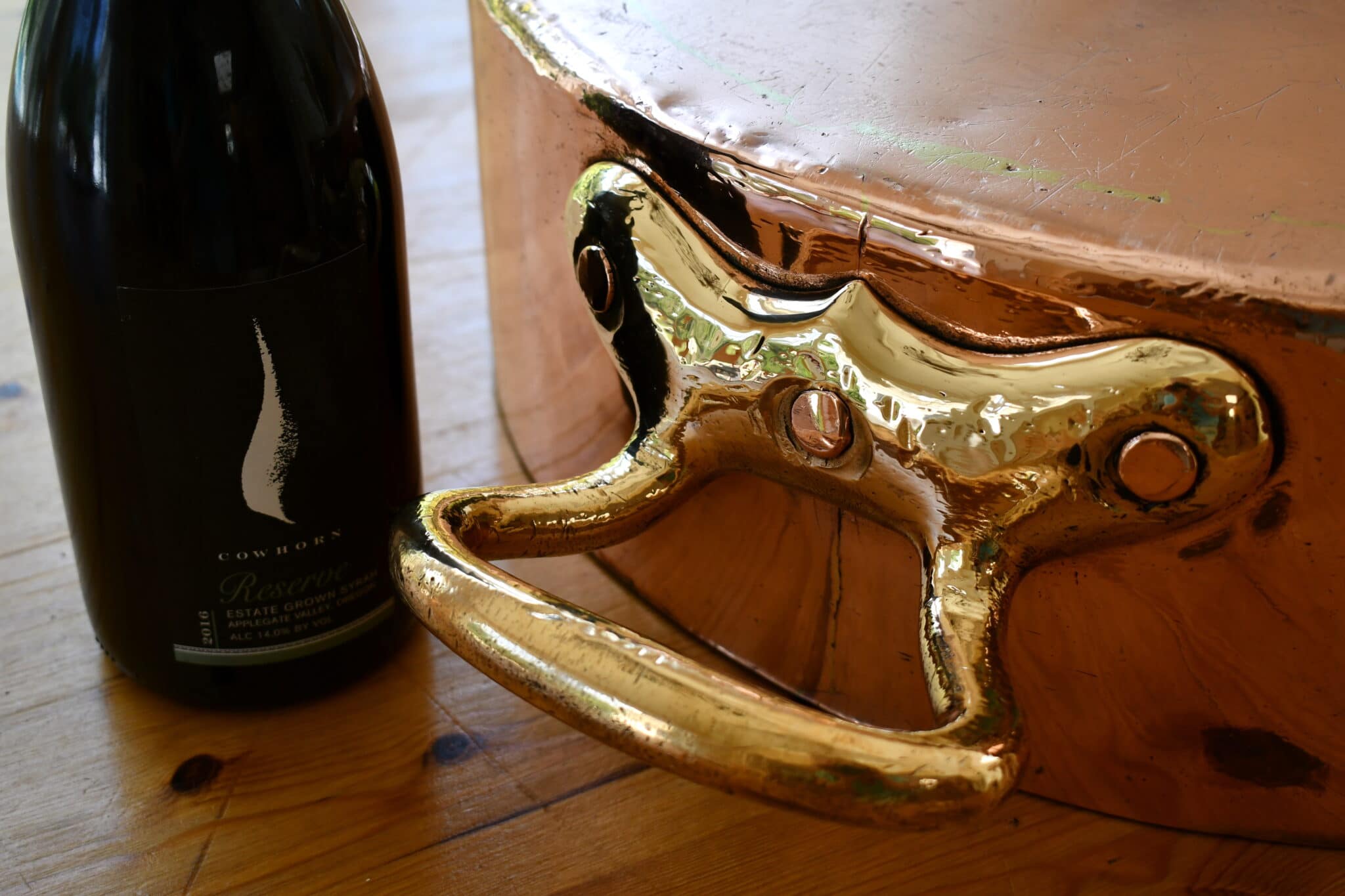





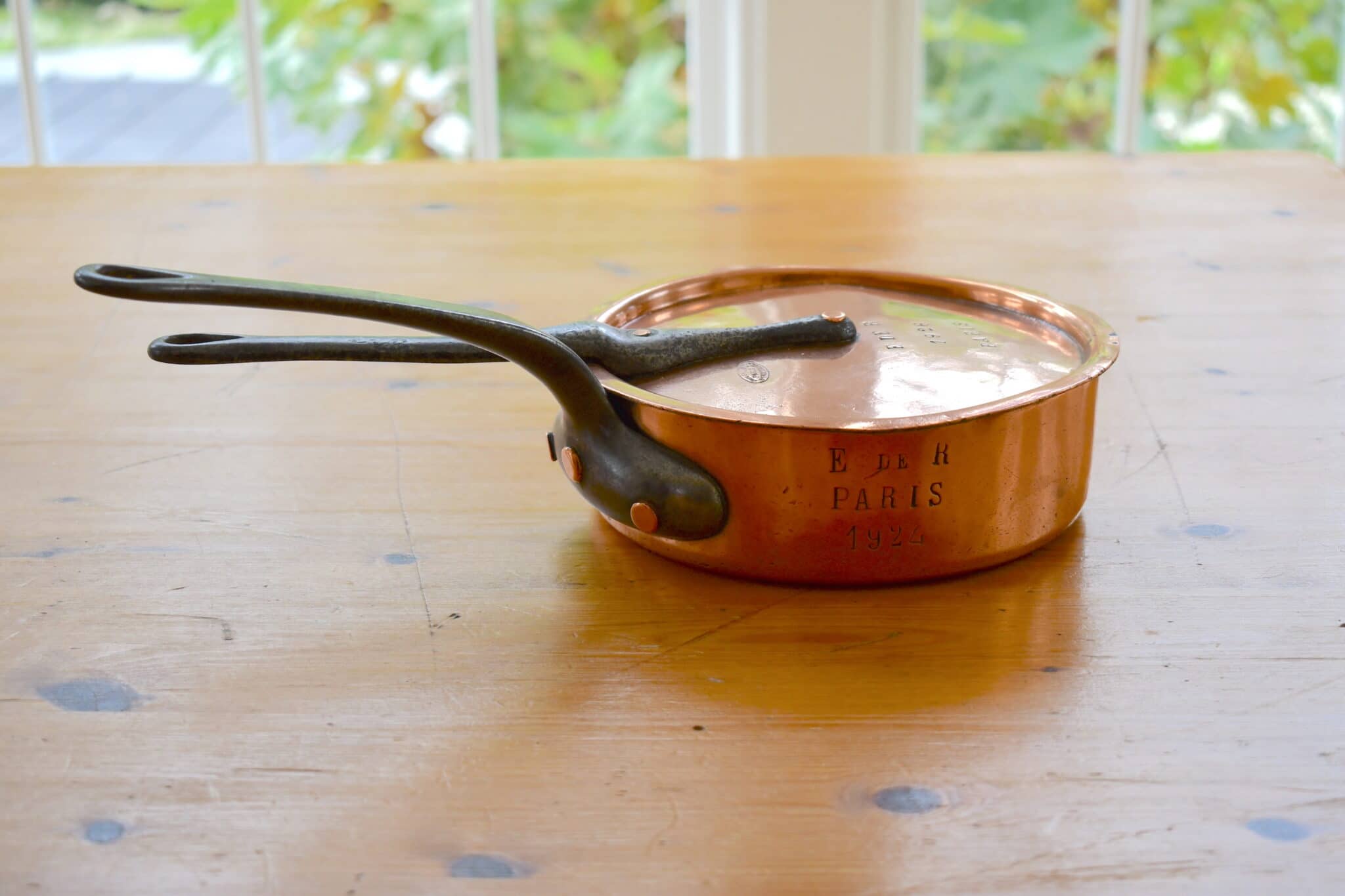
Wonderful addition to your “behemoth” collection VFC. To me it seems evident that the time period for dovetailed construction and formation of the pan from one piece of copper using a press overlapped leaving the date of construction open to conjecture.